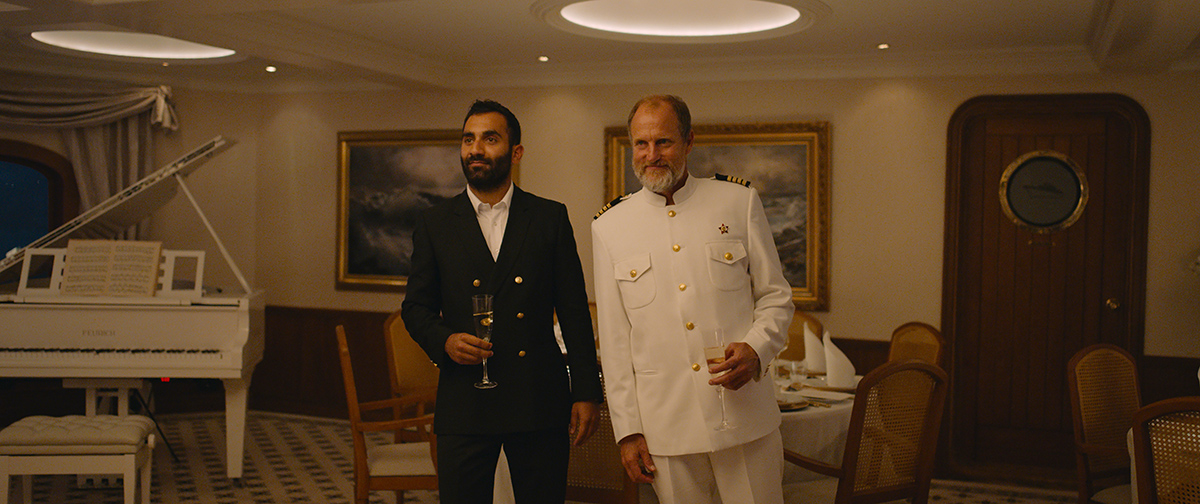
Ruben Östlund, the Swedish writer/director of Force Majeure and The Square, is back with another satire of sex and power. Triangle of Sadness hits theaters this week or next, depending on where you live, and this one is even in English, so you won’t have to scale that “one-inch tall barrier to amazing films,” as Parasite director Bong Joon-ho put it.
Firmly within Östlund’s established wheelhouse, Triangle Of Sadness is another wry send-up of the power dynamics of class, gender, and beauty; a story about a pair of models onboard a luxury yacht full of wealthy folks, and the ship’s crew who serve them. At its best, Triangle Of Sadness looks something like Below Decks meets Parasite, where the social mores of the yachting class are more deeply delved into than on Bravo, combining highbrow class comedy with universal puke and poop jokes (yes, there is sea sickness). Östlund’s scenes are always memorably shot and staged (which is probably what helped win him his second straight Palme D’or at Cannes — Force Majeure won a jury prize) but it’s also hard not to notice that his skewering stick often doesn’t seem all that sharp, especially compared to the aforementioned Bong Joon-ho.
In its opening scene, Triangle Of Sadness looks a lot like arthouse Zoolander (someone make this, please), following British model Carl (Harris Dickinson) to a shirtless casting call where an art director asks him if he can open his mouth a little, so that he “looks more available.” Then he asks whether Carl can relax the “triangle of sadness” in the bottom center of his forehead, and whispers to an assistant that Carl needs Botox. The implication is that Carl, despite looking to all the world like a nubile hunk in the prime of his twinkdom, is already on the downside of his already-precarious career as a male model.
The next scene sees a blow-up argument between Carl and his model girlfriend, Yaya (South African actress Charlbi Dean, who died in August), over who’s picking up the tab at the expensive restaurant. As they attempt to navigate the tricky power politics of who pays when the woman has the bigger salary and securer position, but still on some level expects the man to be “the man,” Östlund goes to increasingly laborious attempts to find innovative ways to shoot two people arguing.
Östlund being Östlund, he manages this beautifully, including a gloriously staged scene in which Carl shouts at Yaya through a sporadically opening and closing elevator door, like Mel Gibson by way of Ace Ventura. At a basic level, Östlund shoots scenes interestingly, which feels increasingly like a lost art in the age of rushed shooting schedules and blueprint-driven prestige TV. Triangle Of Sadness has conversations that feel like car chases.

Carl and Yaya’s curious niche is symbolizing wealth and power without necessarily having much themselves, and they soon end up on a luxury yacht trip where they’re sort of the scholarship kids, there on a free ride surrounded by passengers with real money. These include wild-haired Russian fertilizer magnate Dmitry (Zlatko Buric), who calls himself “the king of shit,” a British land mine manufacturer and his wife, and an awkward tech guy (Henrik Dorson) who’s so rich he offers to buy women Rolexes for taking a picture with him.
Meanwhile, lead steward Paula (the awesomely named Vicky Berlin), with her Susan Powter hair and attitude (Jesus, how old am I?) pumps up her employees to give exceptional service with the promise of “huge tips” — the proverbial scraps from the big boys’ tables. In the film’s best shot, the sounds of Paula’s pep rally echo through the floorboards down into the lower decks, where the Filipino crew dutifully keep the machinery running, presumably without the promise of tips. Östlund has a flair for this kind of compelling imagery, and for absurdism.
As great as Triangle Of Sadness always looks, Östlund has a frustrating tendency to go more broad when you expect him to get more pointed. The film is meant to explore the relationship between beauty and power, which it does, in a broad sense, but I’m also not entirely sure what to make of certain scenes. Like the stroke-addled passenger who can only communicate by shouting the phrase “in den wolken,” which apparently means “in the clouds” in German. Or when the yacht’s drunken captain, played by Woody Harrelson, and Dmitry the shit king, trade barbs insulting capitalism and socialism, respectively. “The Russian capitalist versus the American communist!” Dmitry bellows.
Yes… those are things. There are times when Östlund’s satire spigot just seems to spray wildly like this, with some scenes seeming to function more as white elephants, provocative ways to distract us rather further articulating his themes. In the opening act, there’s a heated, pointed argument about gender roles and power dynamics. Onboard the yacht, it’s class, socialism, and capitalism. And then in the final act, which I won’t spoil, the hierarchy gets flipped on its head and power and beauty collide, or maybe just collude, with a wonderful turn from Dolly De Leon.
They’re all interesting in a vacuum, but I struggle a little with how they fit together, and with the feeling that they all seem to end just when they’re getting good. The movie as a whole starts to feel a little vague. Like Östlund is doing “what if it was about this, now what if it was about that,” until ultimately it’s not that much about anything.
Triangle of Sadness is never boring, which is an achievement in and of itself, but the lack of follow-through leaves you wondering whether Östlund’s feints towards social issues came out of genuine curiosity or if they were just more clever tricks of imagery, beautiful distractions like Carl and Yaya’s ads, designed to be desirable in the moment and forgotten soon after.
‘Triangle Of Sadness’ is playing in select theaters. Vince Mancini is on Twitter. More reviews here.
